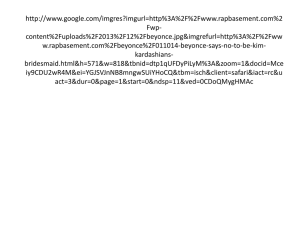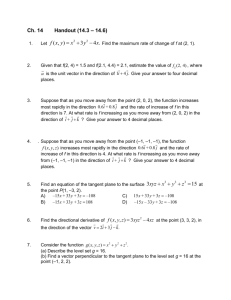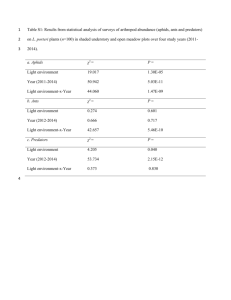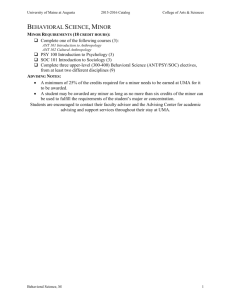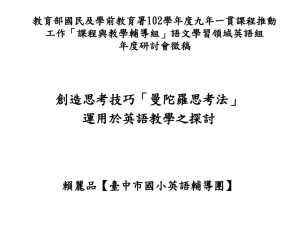Project protocols
advertisement
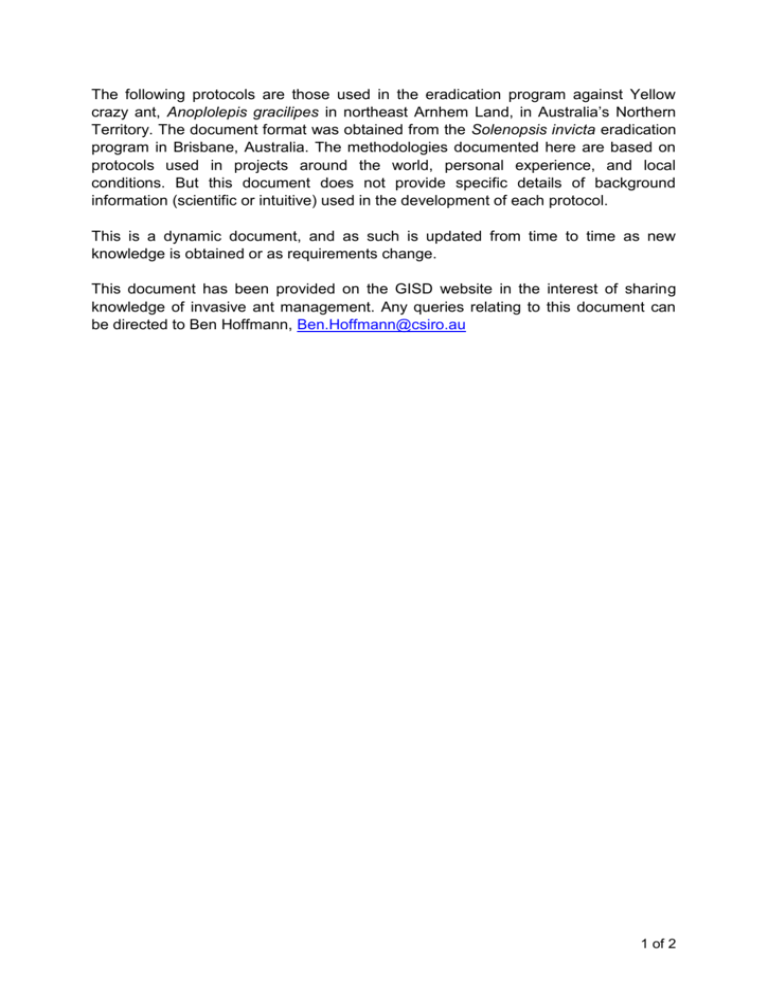
The following protocols are those used in the eradication program against Yellow crazy ant, Anoplolepis gracilipes in northeast Arnhem Land, in Australia’s Northern Territory. The document format was obtained from the Solenopsis invicta eradication program in Brisbane, Australia. The methodologies documented here are based on protocols used in projects around the world, personal experience, and local conditions. But this document does not provide specific details of background information (scientific or intuitive) used in the development of each protocol. This is a dynamic document, and as such is updated from time to time as new knowledge is obtained or as requirements change. This document has been provided on the GISD website in the interest of sharing knowledge of invasive ant management. Any queries relating to this document can be directed to Ben Hoffmann, Ben.Hoffmann@csiro.au 1 of 2 PROTOCOL – Last updated September 2006 INFESTATION DETECTION Purpose The purpose of this protocol is to describe the methods by which infestations of Yellow crazy ant (Anoplolepis gracilipes) will be detected. Background For successful eradication of Yellow crazy ant (Anoplolepis gracilipes) from north-east Arnhem Land, all infestations need to be found. This protocol describes the methods by which these infestations will be detected. Protocols Visual searches for infestations will be conducted in the following locations: 1. All point locations reported by the public as being suspected infestation sites, even if they have been inspected previously. 2. All point locations where vehicles are likely to have stopped in the past 70 years (e.g. camping areas, hunting areas, houses, scrapes, culverts, intersections, etc). 3. Externally of all infrastructure and machinery encountered. 4. Selected point locations at the edges of roads. Within the “hot spot” regions of Gove Peninsula, Central Arnhem Road from Nhulunbuy to Balkpalkbuy, Yaŋunbi, Yudu Yudu, Ganami, Cattle station, and the road to Bakira, inspections to be conducted at 50 m intervals. Remaining roads east of Gan Gan turn off to be inspected at 50-100 m intervals. The Central Arnhem Highway west of Gan Gan turn-off to be inspected at 1 km intervals to the Goyder River. 5. Entire road edges within the rehabilitation areas of the Gove mine site and any other locations considered to be of high probability of infestation that are safely accessible by foot. 6. Other locations opportunistically visited by project staff, project collaborators and interested people. Visual searches for infestations will be conducted in the following ways: Searches will be restricted to early morning (6am-10am) and late afternoon (3pm – 6pm) when temperatures are relatively cool and favourable for ant foraging activity. Search times can be extended on days when there is cloud cover and/or relatively cooler temperatures. Areas to be searched may be burnt at least 2 days prior to survey if it is considered beneficial for access, or safety. All locations inspected are to be recorded in GPS for download into the project GIS. 2 of 2 Disturbance of the litter layer, soil or infrastructure at assessment points is considered beneficial to stimulate ant activity. A search of a point location consists of an assessment of a minimum of four microsites (e.g. tree base, rock, drum) within the general vicinity (approximately 15 m) for at least 5 seconds per microsite. A continuous survey conducted by walking (e.g. along a road or creek) will assess microsites (e.g. tree base, rock, drum) spaced no further than 15 m apart throughout the length of the assessment area, for at least 5 seconds per microsite. 3 of 2 PROTOCOL – Last updated September 2006 INFESTATION EXTENT Purpose The purpose of this protocol is to describe the methods by which the boundaries of Yellow crazy ant (Anoplolepis gracilipes) super-colony infestations will be delineated. Background Yellow crazy ant (Anoplolepis gracilipes) is unicolonial and forms interconnected supercolonies. Following detection of an infestation, the extent of the infestation (boundary of the supercolony) must be determined so that the entire infested area can be treated. Surveys have shown that individual colonies within a supercolony are not as tightly packed in open vegetation as they are in more dense vegetation, and that gaps of up to 100 m and sometimes greater may be present between colonies, making it harder to determine the supercolony boundaries in some locations. This protocol describes the methods by which the extent of each infestation will be determined. Protocols General protocols Assessments will be restricted to early morning (6am-10am) and late afternoon (3pm – 6pm) when temperatures are relatively cool and favourable for ant foraging activity. Work times can be extended on days when there is cloud cover and/or relatively cooler temperatures. Areas may be burnt at least two days prior to survey if it is considered beneficial for access, or safety. A team of no less than three people is required to assess infestation boundaries, unless there is clear demarcation of areas surveyed for less than three people to cover the area required.. Disturbance of the litter layer, soil or infrastructure at assessment points is considered beneficial to stimulate ant activity. Mapping protocols for infestations larger than 2 ha. Starting at a known infestation point, the team is to form a line, with people spaced at least 15 m apart. Walking together in any direction (preferably initially along a landmark (e.g. road edge) continuously surveying microsites until no Yellow crazy ants have been found by any member for at least 100 m. The continuous survey (e.g. along a road) will constantly assess microsites (e.g. tree base, rock, drum) spaced no further than 15 m apart, for at least 5 seconds per microsite. 4 of 2 When the first boundary is believed to have been found, the team re-aligns in what is thought to be perpendicular to the infestation, such that at one person is within the infestation confirming the presence of the ants, and all others are outside confirming the absence of the ant. The team continues searching, constantly re-adjusting their direction based on the presence/absence of Yellow crazy ants. Ultimately, the team will walk in a circle to finish in the same location where they identified the first boundary. Flagging tape can be erected at detection points to visually aid estimating distances and direction. Flagging tape can also be erected as required to allow easy following of the infestation boundary (typically every 20 m). A GPS point indicating presence/absence of crazy ants is to be collected at every location inspection. The GPS data are to be entered into the project GIS to display the infestation extent and survey intensity. The survey where no crazy ants are found around the suspected limit of the infestation need to extend no less than 100m from all detection points. Mapping protocols for infestations smaller than 2 ha. Starting at a known infestation point, the team is to form a line, with people spaced at least 15 m apart. Walking together in any direction (preferably initially along a landmark (e.g. road edge) continuously surveying microsites until no Yellow crazy ants have been found by any member for at least 100 m. The continuous survey (e.g. along a road) will constantly assess microsites (e.g. tree base, rock, drum) spaced no further than 15 m apart, for at least 5 seconds per microsite. Rather than attempting to walk around the infestation as for large sites, the team walks in parallel lines away from, or through the infestation on all sides, until at least 100m is surveyed with no detections from all detection points. Flagging tape can be erected at detection points to visually aid estimating distances and direction. Flagging tape can also be erected as required to allow easy following of the infestation boundary (typically every 20 m). A GPS point indicating presence/absence of crazy ants is to be collected at every location inspection. The GPS data are to be entered into the project GIS to display the infestation extent and survey intensity. 5 of 2 PROTOCOL – Last updated September 2006 INFESTATION TREATMENT Purpose The purpose of this protocol is to describe treatment methodology for eradicating Yellow crazy ant (Anoplolepis gracilipes) from northeastern Arnhem Land. Background Yellow crazy ant (Anoplolepis gracilipes) is known to occur in more than 100 discrete populations within a 100 km radius of Nhulunbuy in northeastern Arnhem Land. Initial surveys have shown that individual colonies within a supercolony are not as tightly packed in open vegetation as they are in more dense vegetation, and that gaps of up to 50 m may be present between colonies, making it harder to determine the supercolony boundaries in some locations. Treatment of these populations must involve broad-scale application of a control agent over the entire known infested area, as well as a surrounding buffer zone. Protocols An infestation is defined as the area that contains all populations of Yellow crazy ant initiating from a point source, or the combined area of multiple point sources where the spread of the colonies have merged to form a common boundary. In addition to every infestation, a 100 m buffer is also to be treated. Areas of exposed water are not to be treated. Where an infestation is located beside a river and the width of the exposed water is greater than 20 m, the area on the opposite side of the river need not be treated. Areas to be treated within 20 m of exposed water must be treated using hand-held applicators. Where possible, all areas are to be burnt at least one week prior to treatment, and records, and in addition where possible, records are to be kept of the date of burning and intensity of the burn (measured by scorch height of the leaves). Presto ant bait is to be applied over the entire treatment area at a rate of 10 kg per hectare. Helicopter flight paths are to be spaced at 12 m (assuming 12 m swath width). There may also be the opportunity to use Pyrifroxifen bait in the form of Distance at the rate of 4 kg per hectare in both areas beside permanent water and the greater treatment area. Bait application is not to occur less than four hours prior to rain, or 24 hours after rain, or if pooled water remains at any time following rain. Applications will be restricted to early morning (6am-10am) and late afternoon (3pm – 6pm) when temperatures are relatively cool and favourable for ant foraging activity. Search times can be extended on days when there is cloud cover and/or relatively cooler temperatures. If it is found that applications conducted in the early morning are 6 of 2 not as reliable as those in the late afternoon, all applications will be restricted to being conducted in the afternoons. Helicopter treatments are not to be attempted if the wind speed exceeds 10 knots. Helicopter operations are to fully comply with CASA specifications. Where helicopter treatment is to be conducted beside or over a road, road signs indicating that helicopter operations are in progress must be placed in clear view of traffic 0.5 km either side of the affected area. Within the Nhulunbuy/Yirrkala region, treatment times and locations are to be published in the Arafura Times and broadcast over Gove FM where possible. A record is to be kept of the actual volume of bait used, and the date of application at each infestation. All safety measures must be adhered to according to the descriptions provided in the Yellow Crazy Ant Treatment Operation Manual. Following post-treatment assessments, small persistent populations can be re-treated by hand if applicable, and if survey confidence is high based on assessment density. If not, then re-treatment by helicopter will be necessary. Given the lack of success found to date within the dense vegetation types of rainforest and vine thicket, a two step treatment will be conducted in these areas, whereby an initial application of Presto at the rate of 10 kg/ha will be followed two months later by an application of Campaign at the rate of 5 kg/ha. 7 of 2 PROTOCOL – Last updated May 2007 POST-TREATMENT ASSESSMENT Purpose The purpose of this protocol is to describe the methods of post-treatment assessments of Yellow crazy ant (Anoplolepis gracilipes) eradication at each treated infestation. Background Yellow crazy ant (Anoplolepis gracilipes) is known to occur in more than 100 discrete populations within a 100 km radius of Nhulunbuy in northeastern Arnehm Land. The treatment of these infestations involves the application of Presto over the entire infested area, as well as the treatment of a 100 m buffer where possible. Post-treatment, intensive monitoring for two years must be conducted without finding any individuals of Yellow crazy ant before eradication can be stated to be achieved. This protocol describes the methods for assessing the success of the treatments. Protocols Eradication success will be assessed in three complementary ways: 1. Visual inspections. A visual inspection will assess microsites (e.g. tree base, rock, infrastructure) throughout an area, with each inspection spaced no further than 15 m apart. Each inspection should last for at least 5 seconds per microsite. 2. Attractive baits. An attractive bait will consist of a teaspoon sized amount of tuna or cat food, placed on the ground and marked by a flag. The bait is left for at least 15 minutes, and then inspected for the presence of ants. 3. Pitfall traps. The pitfall traps used in the assessments of non-target impacts will also be used indirectly to check for the presence of Yellow crazy ants. The following protocols apply for visual inspections and attractive baits Searches will be restricted to early morning (6am-10am) and late afternoon (3pm – 6pm) when temperatures are relatively cool and favourable for ant foraging activity. Search times can be extended on days when there is cloud cover and/or relatively cooler temperatures (thermal tolerances of this ant are currently unreported). Areas to be searched may be burnt at least 2 days prior to survey if it is considered beneficial for access, or safety. All locations inspected are to be recorded in GPS for download into the project GIS. Disturbance of the litter layer, soil or infrastructure at assessment points is considered beneficial to stimulate ant activity. 8 of 2 Baits must be distributed at a density greater than the measured nest density of Yellow crazy ant in each particular environment (preferably no less than one bait per four square metres. PROTOCOL – Last updated May 2007 DECLARATION OF ERADICATION SUCCESS Purpose The purpose of this protocol is to describe the conditions to be met before infested areas may be declared fully eradicated of Yellow crazy ant (Anoplolepis gracilipes). Background Yellow crazy ant (Anoplolepis gracilipes) is known to occur in approximately 100 discrete populations within a 100 km radius of Nhulunbuy in northeast Arnhem Land. The treatment of these infestations involves the application of Presto over the entire known infested area, as well (in most cases) as the treatment of a 100 m buffer zone. Post-treatment, intensive monitoring for two years must be conducted without finding any individuals of Yellow crazy ant before eradication can be stated to be achieved. This protocol describes the conditions to be met before any infestation can be declared to be free of Yellow crazy ant. Protocols Infestations may be declared free of Yellow crazy ants if both of the following conditions are met: 1. The area infested and the surrounding 100m buffer zone (where possible) have been treated by (at minimum) either of the following means: a. Broadscale coverage of Presto ant bait at the rate of 10 kg per hectare. b. Broadscale coverage of Pyrifroxifen bait in the form of Distance at the rate of 4 kg per hectare (proposed in areas beside permanent water). 2. No Yellow crazy ants are found after a minimum of two systematic surveys of the infested area and surrounding buffer zone, post-treatment conducted at least 12 months apart within a 2-year post-treatment timeframe. Surveys to comply with the Eradication Success Assessment protocols. September 06 comment – A single intensive survey 12 months post-treatment finding no individuals might need to be considered as successful eradication given time and logistic constraints of the project. The survey must comply with the Eradication Success Assessment protocols. Likewise, only areas with CA found persisting post-treatment need only be reassessed following a further treatment (no need to re-assess completed areas). To be discussed. 9 of 2
